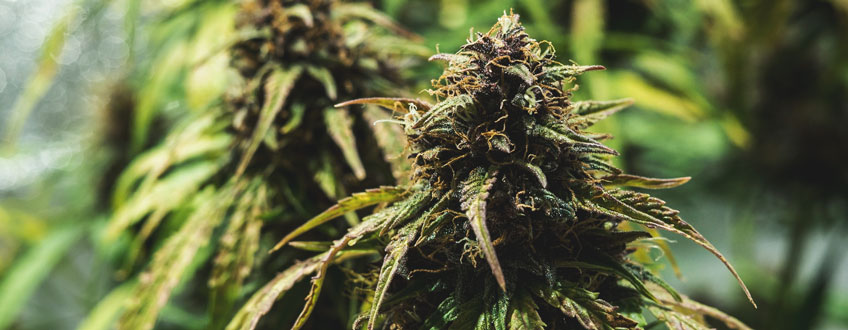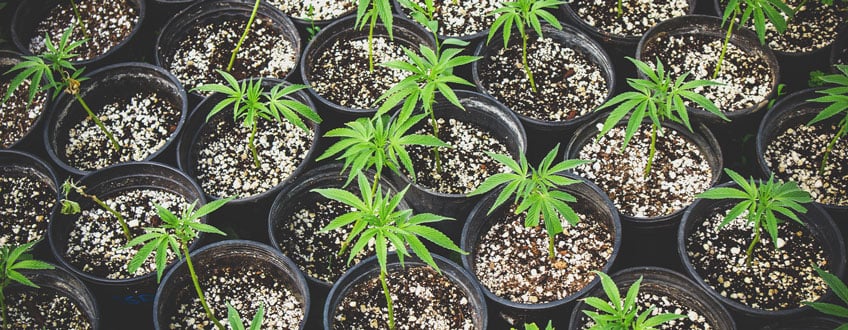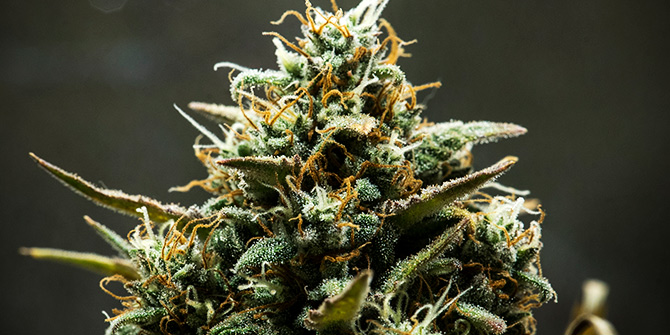9 Myths Surrounding Autoflowering Cannabis Strains
Autoflowering cannabis strains have changed the way cannabis is grown around the world. However, some growers are skeptical about their quality and the internet is full of myths and rumours arguing, that autoflowers are less potent, hardscrabble, and so on.
In this post we look at some of the biggest myths surrounding autoflowering cannabis strains. For more articles like this, follow the RQS cannabis blog.
Innehåll:
- Myth 1: autoflowering strains are less potent
- Myth 2: autoflowering strains produce low yields
- Myth 3: auto strains can’t be transplanted
- Myth 4: you can’t top autoflowering strains
- Myth 5: ruderalis-dominant strains are cbd-dominant
- Myth 6: autoflowering strains don’t flower in time
- Myth 7: autoflowering strains need 24h light cycles
- Myth 8: autoflowering strains cannot be cloned
- Myth 9: autoflowering cannabis buds are tasteless
Myth 1: Autoflowering Strains Are Less Potent

This is probably the most common myth circulating among the cannabis community, and we’re glad to say it’s not true.
This rumour most likely generated around the time of the release of the original Lowryder strain. A cross between Northern Lights #2, William’s Wonder, and a ruderalis variety, this is often considered one of the first autoflowering strains to hit the market.
Lowryder is a medicinal strain designed to help relieve symptoms of stress, insomnia, and pain. It was released over 10 years ago, and was originally less potent than some of the other cannabis varieties on the market at that time, producing light cerebral effects, that had a characteristically slow onset.
However, a lot has changed since the days when Lowryder first hit the streets. Today, autoflowering varieties have significant cannabinoid profiles, which can be rich in THC, CBD, and a variety of other compounds just like their feminized counterparts.
Myth 2: Autoflowering Strains Produce Low Yields

This is another common myth about auto cannabis strains, and again we’re happy to say that it is false.
Much like the previous myth, this one likely originated at the time when Lowryder was first released. Lowryder, as the name suggests, was designed to be a small plant similar to the cannabis equivalent of a bonsai for the discrete grower’s windowsill or balcony. It grew to heights of only about 40cm and hence produced much smaller yields than regular cannabis varieties.
Some other autoflowering cannabis varieties followed suite, also featuring genetics, that left them reaching lower heights and consequently producing less bud than regular plants whose heights could be controlled with light. This is because most autoflowering varieties were traditionally created with stealth and speed in mind.
Today, while some autoflowering varieties still display these traits, others have been expertly bred to produce notable yields of high-quality weed. Thanks to more advanced ways of breeding autoflowers, new varieties can grow just as tall as regular photoperiodic plants and produce similar yields. The main factors that’ll influence this is the genetics of your strain, the strength of your lights, and other factors of your grow environment.
Myth 3: Auto Strains Can’t Be Transplanted
This myth is partially true. Transplanting autoflowering cannabis strains is a little more complicated than repotting regular varieties.
To avoid any complications during their grow cycle, cultivators are generally advised to plant their autoflowering seeds in a container they plan to use through to harvest time. However, it is possible to repot an autoflower, as long as you're gentle and careful.
The biggest concern when repotting autoflowers is shocking the roots, which consequently stunts the plant's growth for up to 7 days, which is significant, because most live only between 60-90 days.
However, letting your plants get rootbound can be just as detrimental to their growth. So, if you have an autoflowering plant sitting in a small container, that you think might get rootbound, don’t hesitate about transplanting it.
To minimize the negative effects of transplanting, remember the following tips:
- Always transplant your plants into the exact same soil or soilless grow medium.
- Transplant your plants before their dark period and when their soil is dry.
- Always pre-soak the medium you're planning to move your plants into.
- Always ensure your transplanted plants aren’t sitting deeper in the soil than they were before. Transplanting them deeper can cause stem rot, which can further stunt their growth.
Myth 4: You Can’t Top Autoflowering Strains

This myth is a hard one to tackle as it divides many autoflower growers.
Some growers swear by topping their autoflowers, arguing that it creates more colas per plant and ultimately increases their yields. Others argue that, with such a short lifetime, the time it takes for plants to recover from topping actually decreases their yields.
Unfortunately, there is no black and white answer to this issue, as we’ve seen it go both ways. Whether or not you should top your autoflowers comes down to the genetics of your plants and your experience as a grower.
If, for example, you’re growing indica-dominant autoflowering plants like some Kush varieties, you probably shouldn’t bother with topping. These plants tend to have only a few internodes and minimal side branching, allowing them to develop big, thick pineapple-like colas.
Some sativa varieties on the other hand, like an autoflowering Amnesia Haze, might respond really well to topping. These plants can easily reach over 150cm and usually respond well to topping, especially during the early stages of vigorous vegetation, allowing for multiple colas and even light dispersion across the top of the plant.
If you want to experiment with topping your autoflowering plants, we suggests trying it out with some of our sativa varieties. You could easily invest in a pack of 3 seeds, leave one to develop without topping, and experiment on the other 2, giving them a top at different stages of the vegetation phase and taking note of the differences.
Myth 5: Ruderalis-dominant Strains Are CBD-dominant

This is another extremely common misconception about autoflowering cannabis strains.
It is true, that all autoflowering strains contain ruderalis genetics, as that is what gives them the autoflowering trait. And it is also true, that Cannabis ruderalis varieties generally contain higher concentrations of CBD than THC.
However, just because a strain is ruderalis-dominant, that doesn’t mean it is naturally going to have a CBD-dominant cannabinoid profile. Thanks to advanced breeding techniques, breeders are now able to create strains, that are ruderalis-dominant, yet still contain higher levels of THC than CBD.
At the same time, breeders are also using the naturally CBD-rich traits of traditional ruderalis varieties to create strains with huge medical potential with high concentrations of CBD, like Fast Eddy (10% ruderalis, high in CBD and 9% THC) and Stress Killer (10% ruderalis, high in CBD and 11% THC).
Myth 6: Autoflowering Strains Don’t Flower in Time
This is myth is an easy one to debunk.
Obviously, the flowering time of each strain varies. Most autoflowering varieties will be ready for harvest in between 60-90 days. When grown in a natural environment, any quality autoflowering plant will be ready for harvest when it should be.
However, the simple variables of a grow environment change that. A slight change in temperature, nutrient dose, or water availability can have a big effect on the way an autoflowering plant develops. Meanwhile, transplant shock, draught, or shock from topping can obviously have even bigger effects on a plant’s growth cycle.
These factors can easily stunt a plant's growth by anywhere from 7 to 10 days, which will then push back your harvest. Hence, it is really important to minimize the risk of any of these factors or deal with them quickly and effectively, should they occur.
Myth 7: Autoflowering Strains Need 24h Light Cycles
This myth isn’t entirely true and depends a lot on the individual strain you’re growing.
It is true, that some autoflowering varieties perform better under 24h light settings and you should definitely keep up these conditions if you’re working with one of these strains.
However, it is widely known that photosynthesis works just as effectively in the darkness, and some strains will make that all the more obvious. In fact, the good old 12/12 light regime might even decrease yields and growth in some varieties that prefer longer dark periods.
While it usually isn't recommended to flower auto strains in less than 16h of light, it ultimately comes down to the individual strain you're working with and the individual results you’re getting.
Myth 8: Autoflowering Strains Cannot Be Cloned

This myth isn’t true. It is possible to clone autoflowering varieties by taking a small branch from a mother and letting it grow under a 24 hour light cycle. However, no one really bothers to do this, as the clones will usually produce lower yields than the mothers. That is why autoflowering seeds are created from previous seeds, not clones.
Myth 9: Autoflowering Cannabis Buds Are Tasteless
Some growers are quick to argue that autoflowering cannabis strains are “all smell”, lacking both flavour and effect. This is definitely not true.
Buds from a decent autoflower created by a reputable breeder will have just as many complex aromas and flavours as those from a non-autoflowering variety. It all comes down to the individual strain and the skills behind the breeder who has created them.
At Royal Queen Seeds, we pride ourselves in creating top-shelf autoflowering cannabis varieties that, unless you grew them yourself, you couldn’t tell apart from regular photoperiodic plants.
To see for yourself, visit our store and browse our autoflowering strains today.
Categories
Växande Autoblommande



































